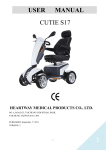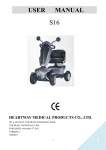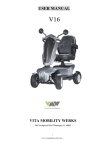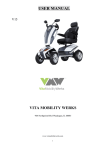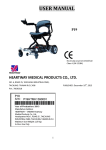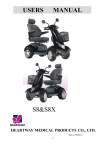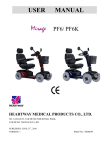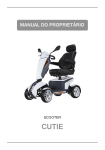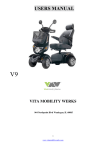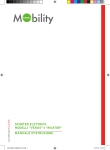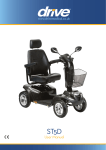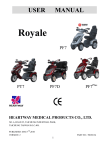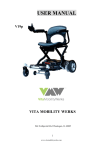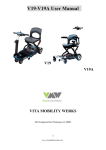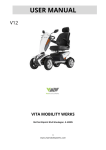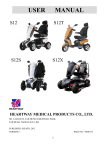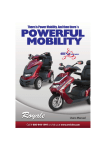Download 1 USER MANUAL S17 Vita Lite
Transcript
USER MANUAL S17 Vita Lite HEARTWAY MEDICAL PRODUCTS CO., LTD. NO. 6, ROAD 25, TAICHUNG INDUSTRIAL PARK, TAICHUNG, TAIWAN R. O. C. 408 PUBLISHED: September 1st -2011 VERSION: 2 1 1 . CONTENTS 1. SAFETY INSTRUCTION……………………………..……...……………................................…3 2. ELECTOMAGNETIC INTERFERENCE(EMI)……………….…………………………………7 3. SPECIFICATIONS………………………….………………..…………….…………………..9 4. BASIS OPERATION OF SCOOTER……......................................................................................11 5. OPERATION OF CONTROL PANEL……………………..……………………………………..14 6. CHARGING INSTRUCTION….……………………………..………….…………...…………..26 7. BATTERY INSTRUCTION & MAINTENANCE…………...………………………….……..…29 8. SCOOTER MAINTENANCE & REPAIR…..…………...………………….………..………..…31 9. CARE AND MAINTENANCE…………………….………..……………………………………32 10. CIRCUIT DIAGRAM…….………..…….……..………………………..…………………..……34 11. BOM LIST DRAWING………………............…………………….………….……….…………35 12. WARRANTY DECLARATION…………………………………………………………..………36 13. DEALER SERVICE INFORMATION….....………………………………………..…………….37 Intend Use :Moving of adult disabled persons by self driving. Maximum user weight: 135 kg; Classified in Class C (EN12184) The product is not intended for visually impaired people. The drivers need to mentally and physically suitable to drive the scooters. The device can’t be used by children until age of 12. The scooter is not for use as a seat in motor vehicle. Please refer to our official website for general product information at www.heartway.com.tw 2 2 SAFETY INSTRUCTION General Always use a seat belt, and keep your feet on the Never operate the scooter while you are under the scooter all the time. influence of alcohol. Never use electronic radio transmitters such as walkie-talkies, or cellular phones. Make sure that there are no obstacles behind you while reserving your scooter. Do not make a sharp turn or a sudden stop while Do not ride your scooter in traffic. riding your scooter. 3 3 Do not attempt to climb curbs greater than Do not leave your hands and legs off the scooter limitation show on Technical Specification when driving. Do not ride your scooter during snow in order to Do not allow unsupervised children to play near avoid accident on slippery road. this equipment while the batteries are charging. Warning – Don’t operate your scooter for the first time without completely reading and understanding this user manual. 1. 2. 3. 4. 5. Don’t operate scooter on public streets and roadways. Be aware that it may be difficult for traffic to see you when you are seated on the scooter. Obey all local pedestrian traffic rules. Wait until your path is clear of traffic, and then proceed with extreme cautions. To prevent injury to yourself or others, always ensure that the power is switched off when getting on or off of the scooter. Always check that the drive wheels are engaged (drive mode) before driving. Do not switch off the power when the scooter is still moving forward. This will bring the chair to an extremely abrupt stop. Do not use this product or any available optional equipment without first completely reading and understanding these instructions. If you are unable to understand the warnings, cautions or instructions, contact a healthcare professional, the dealers or technical supports before attempting to use this equipment, otherwise, injury or damage may occur. There are certain situations, including some medical conditions, where the scooter user will need to practice operating the scooter in the presence of a trained attendant. A trained attendant can be defined as a family member or care professional especially trained in assisting a scooter user in 4 4 6. various daily living activities. Consult with your physician if you are taking any medication that may affect your ability to operate your scooter safely. Do not attempt to lift or move a power scooter by any of its removable parts including the armrests, seats or shrouds. Personal injury and damage to the power chair may result. 7. Never try to use your scooter beyond its limitations as described in this manual. 8. Please do not sit on your scooter while it is in a moving vehicle. 9. Keep your hands away from the wheels (tires) while driving scooters. Be aware that loose fitting clothing can become caught in the drive tires. 10. Consult your physician if you are taking prescribed medication or if you have any certain physical limitations. Some medications and limitations may impair your ability to operate scooters in a safe manner. 11. Be aware when the drive mode is unlocked or locked. 12. Don’t remove anti-tipper if there is any-tipper equipped with the scooter. 13. Contact with tools can cause electrical shock and do not connect an extension cord to the AC/DC converter or the battery charger. 14. Do not attempt to lift or move your scooter by any of its removal parts, such as the armrests, seats, or shroud. 15. When climbing an incline, don’t drive at an angle up the face of the incline. Drive your scooter straight up the incline. This greatly reduces the possibility of a tip or a fall. 16. Don’t climb a slope steeper than the scooter’s limitation. 17. Don’t attempt to have your scooter proceed backward down any step, curb or other obstacle. This 18. 19. 20. 21. may cause the scooter to fall or tip. Always reduce your speed and maintain a stable center of gravity when cornering sharply. Don’t corner sharply when driving scooters at higher speeds. Operating in rain, snow, salt, mist conditions and on icy or slippery surfaces may have an adverse affect on the electrical system. Never sit on your scooter when it is being used in connection with any type of lift or elevation product. Your scooter is not designed with such use in mind and any damage or injury incurred from such use is not the responsibility of Heartway. Don’t touch the motor after driving. It is hot. 5 5 Modifications Heartway Medical Product has designed and engineered power scooters to provide maximum utility. However, under no circumstances should you modify, add, remove, or disable any part or function of your power scooter. Personal injury and damage to the power chair may result. 1. Do not modify your power scooter in any way not authorized by Heartway. Do not use accessories if they have not been tested or approved for Heartway products. Changing of controller parameter shall be only performed by authorized technicians due to the safety concern. 2. Get to know the feel of your power scooter and its capabilities. Heartway recommends that you perform a safety check before each use to make sure your scooter operates safely. 1. 2. 3. 4. Inspections prior to using your power scooter: If equipped with pneumatic tires, please check for proper tire inflations. Please check all electrical connections and make sure they are tight and not corroded. Please check all harness connections and make sure they are secured properly. Please check the brakes. Weight limitation. 1. Please refer to the specifications table for weight capacity information. Power scooter is rated for a maximum weight capacity. 2. Stay within the specified weight capacity for your scooter. Exceeding the weight capacity voids your warranty. Heartway will not be held responsible for injuries or property damage resulting from failure to observe weight limitations. 3. Don’t carry passengers on scooters. Carrying passengers on scooter may affect the center of gravity, resulting in a tip or a fall. Tire inflation 1. If your scooter is equipped with pneumatic tires, it is necessary to check the air pressure at least one time a week. 2. Proper inflation pressures will prolong the life your tires and ensure the smooth operation while 3. riding. Do not under-inflate or over-inflate your tires. It is critically important that 30-25 psi (2-2.4bar) tire pressure be maintained in pneumatic tires at all times. 4. Inflating your tires from an unregulated air source could over-inflate them, resulting in a burs tire. Temperature 1. Some of the parts of the power scooter are susceptible to change in temperature. The controller can only operate in temperature that ranges between -25℃ ~ 50℃. 2. At extreme low temperatures, the batteries may freeze, and your power scooter may not be able to operate. In extreme high temperatures, it may operate at slower speeds due to a safety feature of the controller that prevents damage to the motors and other electrical components. 6 6 ELECTROMAGNETIC INTERFERENCE (EMI) The rapid development of electronics, especially in the area of communications, has saturated our environment with electromagnetic (EM) radio waves that are emitted by television, radio and communication signals. These EM wave are invisible and their strength increases as one approach the source. All electrical conductors act as antennas to the EM signals and, to varying degrees, all power wheelchairs and scooters are susceptible to electromagnetic interference (EMI). The interference could result in abnormal, unintentional movement and/or erratic control of the vehicle. The United States Food and drug Administration (FDA) suggests that the following statement be incorporated to the user’s manual for all power scooter like the S17. Power scooters may as susceptible to electromagnetic interference (EMI), which is interfering electromagnetic energy emitted from sources such as radio stations, TV stations, amateur radio (HAN) transmitter, two-way radios, cellular phones and alarm systems of shops. The interference (from radio wave sources) can cause the power scooter to release its brakes, move by itself or move in unintended directions. It can also permanently damage the powered scooter’s control system. The intensity of the EM energy can be measured in volts per meter (V/m).Each powered scooter can resist EMI up to a certain intensity. This is called “immunity level”. The higher the immunity level the greater the protection. At this time, current technology is capable of providing at least 20 V/m of immunity level, which would provide useful protection against common sources of radiated EMI. Following the warnings listed below should reduce the chance of unintended brake release or powered scooter movement that could result in serious injury: 1. Do not turn on hand-held personal communication devices such as citizens band (CB) radios and cellular phones while the powered scooter is turned on. 2. Be aware of nearby transmitters such as radio or TV stations and try to avoid coming close to them. 3. If unintended movement or brake release occurs, turn the powered scooter off as soon as it is safe. 4. Be aware that adding accessories or components, or modifying the powered scooter, may make it more susceptible to interference from radio wave sources (Note: It is difficult to evaluate the effect on the overall immunity of the powered scooter). 5. Report all incidents of unintended movement or brake release to the powered scooter manufacturer, and note whether there is a radio wave source nearby. TURN OFF YOUR POWERED SCOOTER AS SOON AS POSSIBLE WHEN EXPERIENCING THE FOLLOWING: 7 7 Unintentional scooter movements Unintended or uncontrollable direction. Unexpected brake release The FDA has written to the manufacturers of power scooters asking them to test new products to be sure they provide a reasonable degree of immunity against EMI. The FDA requires that a powered wheelchair should have an immunity level at least 20 V/m, which provides a reasonable degree of protection against more common sources of EMI. The higher the immunity level the greater the protection. Your powered scooter has an immunity level of 20 V/m which should protect against common sources of EMI. Warning: The scooter itself can disturb the performance of the electromagnetic fields such as emitted by alarm systems of shops. 8 8 S17 - TECHNICAL SPECIFICATIONS MODEL S17 WEIGHT CAPACITY 135kgs(300 lbs) SEAT: TYPE/SIZE 18" A2 REAR DRIVE WHEEL 280mmx100mm(11"x4") FRONT WHEEL 280mmx90mm(11"x3.5") ANTI-TIPPER None MAX SPEED 12KM/H (7.5 M/H) BATTERY SPECIFICATIONS 12V 50Ah x 2pcs BATTERY RANGE 35km (22 Miles) CHARGER TYPE 5Amp,Off Board, Volt: 120 or 240 (50/60Hz) CONTROLLER TYPE Dynamic Rhino2 120Amp MOTOR TYPE 5100rpm,700W WEIGHT: W/ BATTERY 110kgs(240 lbs) WEIGHT: W/O BATTERY 85kgs(190 lbs) TURNING RADIUS 1200mm SUSPENSION FULL LENGTH 1320mm WIDE 670mm HEIGHT 1160mm SEAT WIDTH 460mm SEAT HEIGHT 460mm SEAT DEPTH 460mm BACK HEIGHT 560mm WHEEL BASE 935mm GROUND CLEARANCE 100mm LEG ROOM 320mm Height of Kerb for descending Same as 100 mm Max Force For Controller Device Engaging lever: 30 N Disengaging lever: 35 N Throttle lever: 3N Push button: 1.5 N Max Climbing Ability 10 Degree Max Safe Slope 10 Degree 9 9 Disclosure information min. Overall length with legrest Overall width mm mm max. 1400 m m 700 mm 1400 m m Folded length mm Folded height mm 127 mm Total mass Mass of the heaviest part Static stability downhill Static stability uphill kg 138 kg 22.0 kg seat kg Seat plane angle 15.1 2 480 mm 480 mm Effective seat width 510 mm 510 mm Backrest height Footrest to seat distance max. Effective seat depth Seat surface height at front edge Backrest angle 15.1 min. Leg to seat angle mm mm 0 12 750 mm mm 460 mm 460 mm - - Static stability Armrest to seat 230 mm 230 mm 15.3 sideways distance Energy Front location of km 40 km consumption armrest structure Dynamic Handrim diameter mm mm 10 stability uphill Obstacle Horizontal location of - 150 m mm 100 mm - 150 mm climbing axle I m Maximum 6.1 km/ Minimum turning radius km/h 2015 mm speed forward h Minimum horizontal 0.9 m Minimum turn-around 2500 mm braking distance Width from max speed The scooter seat is tested according to EN1021 regarding resistance to ignition, but it is recommended to avoid users of flame near the scooters and smoking during sitting on the scooter. The electric system of this scooter is in compliance with ISO 7176-14:2008 10 10 BASIC OPERATION OF SCOOTER Driving and braking You can use the throttle lever to control the forward speed or the reverse speed of your scooter. Please refer to the following instruction to move forward/backward your scooter. Switch to forward or backward mode by clicking one of the F/R Button. If you re-press the same button again, then the scooter will drive in opposite direction Use your finger to press on the throttle lever in order to move forward or move backward Switch to Backward or Forward Switch to Forward or Backward Throttle Level Please release the throttle lever and then allow your scooter to come to a complete stop. The automatic brake will become activated if the transferring speed is more than 30% of the maximum speed while the scooter is driving down-slope at free-wheel mode. 11 11 WARNING ! Engaged Disengaged (Free Wheel) Please be noted that the scooter will be at free-wheel mode, when the motor is disengaged. To use the parking brake, you must move and lock the lever into the engaged position! When your power scooter is in freewheel mode, the braking system is disengaged! Use the freewheel mode only with an assistant! The assistant may operate the engaging lever to apply the parking brake. Tiller Positioning Press down the lever and adjust it into your preferred position. Never attempt to adjust the tiller while the scooter is in motion. Make sure the tiller is at a comfortable setting and located securely. Warning: The temperature of scooter surface can increase when the scooter is exposed to external source of hear (e.g. sunlight) For any mechanical adjustment on the tiller or on the seat, be aware of trapping and squeezing of your fingers. 12 12 How to remove the seat Please refer to the following instructions. 1) Press the swivel lever 2) Swivel the seat 3) Pull the seat upward (Two persons are required to remove the seat) 4) Removing the battery and seat from the scooter is allowed before transporting. 13 13 OPERATION OF CONTROL PANEL LCD(Liquid Crystal Display)Power Scooter Control Panel Model LCD(Liquid Crystal Display) Function 1. Power Indicator:Battery remaining capacity and charging indicator (6 squares + Battery Icon) 2. Clock:Hour / Minute / Second display and setting. 3. Speed Sensor:7 Segment display (2.5 digits +1 decimal) + “km/h / mph” symbol 4. High/Low/ Turn Speed:Indicated as “H” and “L” symbols 5. Odometer:ODO(99999km max)、TRIP(99.9 max) 6. Headlight:“Power-saving” mode, Green LED 7. Back-up Lamps:“Brake / Reverse” modes, Orange LED 8. Forward control: Forward mode. Signal is always on. 9. Backward control: Backward mode. Signal keeps flashing. 10. Right-Indicator:Flash mode, Green LED 11. Left-Indicator:Flash mode, Green LED 12. Parking Lamp:Including “Reverse Mode”, left- indicator and right-indicator flashing simultaneously, Red LED 13. Malfunction Code:7 Segment display (1digit ) + Warning symbol + Red LED 14. Power-on Scan:All LED turn on. 5-second backlit flash. Button light on. 15. TEMP Gauge:ºC and ºF modes 14 14 Button Left(F/R):Backward control Right (F/R): Forward control :Left-Indicator control Right-Indicator control: :High/low speed switch :Parking :Horn Headlight LED Indicator :Horn : MODE (Left) /SET (Right) Back-Up Light Right & Left indicator (Green) ,Parking light (Red),Warning light (Red),Back-up lamps (Yellow),Headlight (Blue) LED Backlit LED Backlit (White) Connector 20PIN AMP Usage Condition 1. Voltage & Temperature ITEM SPECIFICATION Voltage DC24 V Operation Voltage DC 16 ~32 V Storage TEMP. -40℃ ~ 65℃ Operation TEMP. -25℃ ~ 50℃ Meter Angle at 30 of elevation while scooter assembly (LCD orientate to six o’clock) Handle Cover 2、General Characteristic Performance Test (20 5℃) 2.1、Hardware Circuit: ITEM Lowest Operation VOLT Consuming Current (VB = 24.0V) SPECIFICATION RESULT 16 V max Dynamic: 1 A max Static: 3 mA max ( Key OFF status) 15 15 Operating Instruction 1.Speed Sensor and Display ITEM SPECIFICATION Operation Features Speed detection by speed hall sensor from transaxle with conversion at 1821 rpm equal to 60km/h. Tolerance 5~15% (±2%) Digital Range 0~199 km/0~124 mile Display Switch Button Initial setting at km/h. Switch to MPH by MODE and SET buttons 2.High /Low Speed Setting ITEM Operation Features SPECIFICATION (1) Trigger buttons to switch from high-speed to low-speed (also from low-speed to high-speed), then set the number of segments from 1 to 5 .The setting time will take 5 seconds for each segment. (2) L will flash while turning at corner. (3) As a constant speed detector to determine the signal, the speed light will flash while travelling at constant speed. Symbols on LCD "H"symbol means “High Speed” –Corresponding from 1-5 "L"symbol means “Low Speed” – Corresponding from 1-5 "L"symbol flashing means “Turning at the corner” Flicker Frequency 1 sec 16 16 3.Power Indication ITEM SPECIFICATION Remaining Capacity Voltage (V) Scale Bar (%) 100 > 25.42 (6) 85 (5) 70 (4) ≦ 25.42 ≦ 25.12 Battery Remaining Capacity 55 (3) 40 (2) 30 (1) ≦ 24.78 ≦ 24.42 ≦ 23.88 and Flashing Low-power 20 Warning LED Flashing Warning Flicker Frequency Operation Characters Every 2 sec. (1) Scale status only decrease, won’t increase. (2) When the remaining capacity was less than 30%, warning sound (“Be-Be” two short sounds) act at 5 seconds intervals. While (a) Key Off (b) Charging Mode (c) Sleep Mode, warning sound released. 17 17 ITEM SPECIFICATION Remaining Capacity (%) Voltage (V) Scale Bar 40 < 25.44 (2) 55 > 25.44 (3) 70 Charge Indication > 26.18 (4) 80 > 26.92 (5) 90 > 28.5 (6) 100 (7) Increase Frequency Operation Character Remarks 0.5 sec. (1) Scale status only decrease, won’t increase. (2) Take the PIN3(CH3) of charger as determinant signal, enter「Charging Mode」when CH3 grounding (L), not only “KEY ON” or “KEY OFF”. Above scale bar status only for reference, must take the indicator of charger as the precise diagnosis. 18 18 4.Clock Meter ITEM SPECIFICATION Tolerance (per day) ± 2 sec Initial Setting Value 『Hour:Min』mode :『AM 12:00』 『Hour : Min』 Display range : AM12:00 ~ PM11:59 Setting (12-Hour format) When『Hour』is between 1 and 9 o’clock, displayed at 1~9. 5.Odometer ITEM Operation Features Display Switch Button SPECIFICATION Odometer detected by the signal of Opto Coupler then converts into distance. 「km/h」 means the odometer displayed as kilometer. 「mph」 means the odometer displayed as mile. (1) Display Range:00000~99999 Accumulative Display [ODO] (2) Once the total mileage up to 99999km or 62149mile (99999÷1.609mile), the counter will restart from “00000”. (1) Display Range:00.0~99.9 TRIP Counter (2) When over 99.9km, display stop counting (won’t restart from “00.0”). Operation status (1) Odometer indication display on ODO mode when Power On, then switch to TRIP mode after 5 seconds. (2) TRIP can be reseted to “00.0”. 19 19 6.Headlight Control ITEM SPECIFICATION Take exterior headlight switch as determinant signal. Operation Feature (1) Switch on/off the head light by pressing button on/off simultaneously. (2) LCD backlights turn on / turn off with head light. once, then LED Power Saving Mode When motor stops, the modulation down to 30% (Headlight) When motor acts, 100% output power (Headlight) Usage Condition While (a) KEY OFF (b) Power-Saving mode (c) Sleep mode, all functions closed. will turn (1) 2.2V>WIP>2.8V ( 100% Full-power ) Determinant Condition (2) 2.2V<WIP>2.8V ( 100% Full-power ) (3) Power saving mode /Full power output: instant reaction Full power output/ Power saving mode: 5 seconds delay (1) Loop Load: 24V/50W max (2) With “short circuit” and “overload” protection Remarks 7.Back-up Lamp control ITEM SPECIFICATION Take exterior back-up lamp switch as determinant signal. Operation Feature (1) Switch on/off the head light by pressing button turn on/off simultaneously. (2) LCD backlights turn on / turn off with head light. once, then LED will (Control Mode) When motor changes from act (go forward) to stop, the lamp reinstated after flashing for 5 sec. Brake-lamp Mode Reversing-lamp Mode Determine as “Reversing Mode”, back-up lamp keep flashing. Reverse warning sound can be set by panel ( Turn on / Turn off) Usage Condition While (a) KEY OFF (b) Charging Mode (c) Sleep Mode, all functions closed. * Brake-lamp & Reversing-lamp Mode won’t be limited by Back-up lamp switch on or off. Flicker Frequency 1 sec. 20 20 ITEM SPECIFICATION (1) 2.2V>WIP>2.8V ( 50% Half-power ) (2) 2.2V<WIP>2.8V ( 100% Full-power ) Determinant Condition (3) Full / Half power switch at real time. (4) The determination of “Reversing Mode” need to consider the motor direction and panel setting. (1) Loop Load : 24V/50W max (2) With “short circuit” and “overload” protection Remarks 8.9.10 Indicators and Parking Lamp Control ITEM SPECIFICATION Operation Feature Left-Right indicators and parking-lamps switch are considered to be the determinant signal. After pressing button Control Mode (Left-direction lamp) left-indicator and Press , the right-indicator and will flash and the warning sound will act too. again to turn off left-indicator. After pressing the button (Right-direction lamp) right-indicator and turn off right-indicator. After pressing button (Parking lamp) will turn off. The , the left-indicator and will turn off. The will flash and warning sound will act. Press once, the again to will turn on. Both right-left indicators and will flash and warning sound will act .Press Parking lamp function. again to turn off the Usage Condition While (a) KEY OFF (b) Charging Mode (c) Sleep Mode, all functions closed. Flicker Frequency 1 sec. Warning Sound Frequency One short “Bi” sound per second Remarks (1) Load circuit for left-direction light: 24V/0.8W max (2) Load circuit for right-direction light: 24V/0.8W max (3) With “short circuit” and “overload” protection 21 21 11. Malfunction Message 22 22 12. Power on Self-Test ITEM SPECIFICATION Initial Status When scooter power on, the control panel will go through a self-test routine; the backlight and all LCD segments will be tuned on for 3 seconds, then switch automatically to the general operation mode (ODO). 13. Temperature Sensor ITEM SPECIFICATION Operation Temperature detected by temperature sensor (NTC) from transformation with signal. Feature Tolerance 2C Display Range -20C ~50C -4F ~122F Display Switch Button When display C, degree stand for Celsius thermometer When display F, degree stand for Fahrenheit thermometer 14. Reverse Indicator ITEM SPECIFICATION Operation Take exterior forward / backward switch as determinant signal. Feature Press “Forward” button to switch to driving forward Forward/Reverse Mode Press “Reverse” button to switch to driving reverse Flicker Frequency 1 sec. 23 23 15:Buttons ITEM SPECIFICATION Button General (TRIP) Left-Hand: MODE Button Display Mode Right-Hand: SET Button for 3 seconds to reset TRIP at “00.0”. Press SET Press MODE and SET simultaneously for more than 2 seconds. to enter “Setting Mode”, then 『Hour:MIN』start flashing. (1) When『Hour』flashing: Press SET to increase of number, then press MODE to enter “Setting Mode” of MODE to enter “Setting Mode” of 『MIN』. (2) When『MIN』flashing: Setting Mode Press SET to increase of number, then press 『km/h & mph』. (3) When 『km/h』 or 『mph』flashing Press SET to choose “km/h” or “mph” type, then press .MODE to enter “Setting Mode” of 『C / F』 (4) When『C』or『F』flashing Press Escape Mode from SET to choose C or F . Under setting mode, if below situations happened, will auto save the last setting value then Setting escape to general operation mode. (1) No any operation of ADJ button for 20 sec. (2) Press MODE and SET at same time for more than 2 sec. (1) 『Hour:Min』,『km/h』or『mph』,『C』or『F』offer Cyclical Switch function. (2) When adjusting 『Hour:Min』, press SET to increase number, if press SET for Operation Status more than 2 seconds, the number will increase continuously until button released, setting value with Cyclical Switch function (only 2 seconds from 0 to 9). * If『Hour』less than 10, the denary “0” doesn’t display.。 Remarks Button tones: one short “Bi” sound 24 24 16. Backlit LCD Backlit Press "MODE" key or "SET" button, the backlight will turn on. (None-Light Mode) Backlit will be turned off automatically if the button is not touched by users for 5-second long 17.System device Controller Charger Battery Wig Wag Bulb S-Drive, 120 Amp CTE 5A 50-Amp (Two Pieces of Batteries) CTE NCW-K001 LED Lighting system Speed Control 1. Press H/L gear mode in order to change to H mode to L mode. Press Hold Press Hold button once in order to increase speed from scale 1 to scale 5. button and do not release it in order to reach the maximum speed level. button once in order to decrease speed from scale 1 to scale 5. button and do not release it in order to decrease the speed to the slowest level. 25 25 CHARGING INTRUCTIONS Battery Charger Instruction 5A 2. SPECIFICATION Item BATTERY CHARGER (SWITCHING MODE) Model 4C24050A Output Current(DC) 5A Charging Voltage(DC) 28.8V Floating Voltage(DC) 27.6V Input Current (AC) 4/2 A Input Voltage(AC) 115 Vac Or 230 Vac 50/60 Hz (Manual Select) Efficiency AC-DC 80% min Operating Temperature 0°C ~ 40°C Performance Switching Mode Charging Method Battery Application Constant current two stage constant voltage 24V Lead Acid Rechargeable Battery (20Ahr ~ 60Ahr) 1. Short Circuit Protection 2. Output Voltage/ Current Limit 3. Reverse Power Protection 4. Overheat Detection Output Detection Operating Temperature 0~ 40 Degree (Celsius) Measure L 190mm×W 100mm×H 55mm Weight 965g Color Black 26 26 3. OPERATING INSTRUCTION (1)Make sure the battery charger output voltage is the same as the connecting battery. (2)Plug in the power cord. LED indicates green flash when AC power on. (3)Connect the battery charger to the battery. (4)Start charging; please refer to 4. LED INDICATION 4. LED INDICATION (1)Green Flash:Power on (2)Orange:Charging (3)Orange Flash:Pre charge (4)Green & Orange Flash:Charged 80%。 (5)Green:Full charged(Floating charge)。 (6)Red: Error / Abnormal temperature Red indication keeps flashing: 1V< Battery voltage < 9V Red indication keeps flashing X 2: a) Wrong connection b) Short circuit c) VBAT <16V Red indication keeps flashing X 3: a) VBAT > 28.8V (can’t charge the battery) b) Battery and Jimmy are defective Red indication keeps flashing X4: a) Charging system defective b) Battery defective partially Red indication keeps flashing X5: a) Charging hours exceeds 24 hours Red indication keeps flashing X6: a) Battery voltage < 16V (12V Battery) Red indication keeps flashing X7: a) Abnormal temperature occurs during battery charging 5. TROUBLE SHOOTING (1) If green indicator is off: ․Check AC input. If it works functionally, the battery charger may be defective. (2) If green indicator keeps flashing and cannot turn to charging indication: ․Check if the battery connector is connected successfully. ․Check if there is any short circuit on the output connection. ․The battery charger may be defective if the battery connection works functionally. (3) If red indicator keeps flashing: ․Check if the battery connection is reversed. ․Check if there is any short circuit on the output connection. ․Check if the environment temperature is too low (0oC) ․The battery charger may be defective if the red indicator still keeps flashing. 27 27 (4) Charging indicator (orange) cannot turn to green: ․The battery might be defective, please stop charging and have the battery be repaired. (5) If the charging indicator (orange) turns to green (fully charged) immediately: ․The battery may be in well-charged condition. ․The battery may be defective if the battery is not fully charged. 6. CAUTION (1) Before using the battery charger, read all instructions and cautionary markings. (2) Use the battery charger in a well-ventilated area (3) To avoid the risk of injury, charge only lead-acid or gel cell type rechargeable batteries. (4) Please turn off the power before charging (5) Plug the off-board charger power cord into the charger port during battery charging. Off-Board Charger Port The off-board charger port is mounted on the tiller. Note: Only use the battery charger which was provided by the scooter supplier. The use of any different type of charger can be hazardous and need the approval of the manufacturer. WARNING ! Always charge your batteries in well ventilated areas. The charger is intended for indoor use only. Please protect it from the moisture. For maximum performance, it is recommended that you replace both batteries at the same time if the batteries are weak. If the scooter will not be used for a long period of time, arrange to have the batteries recharge at least once every month to avoid deterioration of the batteries. Can we use a different charger? Please understand that chargers are selected specifically for particular applications and matched to the type and size of specific batteries. In order to charge your scooters safely and efficiently, we recommend use of the charger supplied as original equipment with your Heartway product only. Any charging method resulting in batteries being charged individually is prohibited. 28 28 BATTERY INSTRUCTION & MAINTENANCE Read through the charger operating instruction before using it. If you use your scooter every day, please charge its batteries as soon as you finish using it for the day. Your scooter will be ready each morning. Avoid deeply discharging your scooter’s batteries. Charge the battery at least 24 hours a week if the power chair or scooter has not been used. (This is to make sure that the electrolyte is always at the top level) If the battery cannot be charged (Orange light cannot turn to Green) or if the Orange light turns to Green immediately, please check it with the technicians. The battery may be defective. The voltage difference between the two batteries on a power unit cannot be more than 0.5 V; the battery case should be inspected for cleanliness and evidence of damage. If the charger indicates red light, please kindly check if the charger is defected or if the cable wiring connection is poor. Please keep the battery and ⊕connectors clean otherwise the charging condition will be poor. To Change the batteries in your scooters: Remove the battery cover and captain seat. Unfasten the battery tie-down strap. Disconnect the battery harnesses properly. Disconnect the battery by opening two gray main connectors and also three smaller connectors (two white and one red). Remove the old batteries from the battery wells. Place a new battery in each battery well. Reconnect the gray connectors. Check the terminal boots for correct position.. Reconnect the battery tie-down strap. Reinstall the battery cover and seat back to the scooter. Removing the battery and seat from the scooter is allowed before transporting. 29 29 WARNING! Please remove connectors first before removing the battery. If you hand is wet or sweaty, Do NOT replace the batteries. Please always use two batteries of the same type at the same amp-hour capacity. Always replace both batteries at the same time. Please do not mix old and new batteries together. 30 30 SCOOTER MAINTENANCE & REPAIR Your power scooter is designed for minimal maintenance. However, like any motorized vehicle it requires routine maintenance. To keep your power scooters or power wheelchairs for years of trouble-free operation, we recommend you follow the following maintenance checks as scheduled. Maintenance Job Daily Weekly Monthly Semi-Annual Electrical System Battery meter – Inspect the battery meter to determine if batteries are needed to be re-charged Controller / Display panel – Make sure they are not frayed or have any exposed wiring Check all plug & wiring connections for firm condition Have the batteries been fully charged before the daily operation Are all holder and screws firmly fixed and safe? Are all electric lighting system (if applicable) in working order Tyres & Wheels Have pneumatic tyres checked for necessary air pressure Front & Rear wheels must be able to spin smoothly without any interference Rear & Front wheels must spin without wobbling Visually inspect the tire tread. If less than 1mm (1/32”), please have your tires replaced by your local dealer. Others Motor brushes. We recommend that your authorized dealer inspect the brushes every six-month if your power scooter or power wheelchair is not operating smoothly. If the inspection determines excessive motor bushes worn out, they must be replaced otherwise the motor damage will result. 31 31 CARE AND MAINTENANCE Scooters require a minimal amount of care and maintenance. The following areas require inspection and/or care and maintenance. TIRE PRESSURE If equipped with pneumatic tires, always maintain the air pressure in psi rating indicated on each tire. Your power scooter comes with standard pneumatic tyres. If your power scooter comes with optional air tires, make sure to maintain the pressure of the tires between 30-35 psi (2.0 – 2.4 bar). It is important that the air pressure in psi rating indicated on each tire be maintained in pneumatic tires at all times. Do not overinflate your tires. Low pressure may result in loss of control, and overinflated tires may burst. Failure to maintain the air pressure in psi rating indicated on the tires at all times may result in tire and/or wheel failure. Regularly inspect your scooter’s tires for signs of wear. CLEANING AND DISINFECTION Use a damp cloth and mild, non-abrasive cleanser to clean the plastic and metal parts of your scooter. Avoid using products that may scratch the surface of your scooter. If necessary, clean your product with an approved disinfectant. Make sure the disinfectant is safe for use on your product before application. Follow all safety instructions for the proper use of the disinfectant and/or cleaning agent before applying it to your product. Failure to comply may result in skin irritation or premature deterioration of upholstery and/or scooter finishes. BATTERY TERMINAL CONNECTIONS Make certain that the terminal connections remain tight and uncorroded. The batteries must sit flat in the battery wells. The battery terminals should face towards the inside of the scooter. WIRING HARNESSES Regularly check all wiring connections. Regularly check all wiring insulation, including the charger power cord, for wear or damage. Have your authorized dealer repair or replace any damaged connector, connection, or insulation that you find before using your scooter again. 32 32 AXLE BEARINGS AND THE MOTOR/TRANSAXLE ASSEMBLY These items are all prelubricated, sealed, and require no subsequent lubrication. WHEEL REPLACEMENT If your scooter is equipped with pneumatic tires and you have a flat tire, you can have the tube replaced. If your scooter is equipped with solid tire insert either the solid insert or the entire wheel must be replaced depending on the model. Contact your authorized dealer regarding replacement wheels for your scooters. MOTOR BRUSHES The motor brushes are housed inside of the motor transaxle/assembly. They should be inspected periodically for wear by your authorized dealer. CONSOLE, CHARGER, AND REAR ELECTRONICS Keep these areas free of moisture. Allow these areas to dry thoroughly if they have been exposed to moisture before operating your scooter again. STORING YOUR SCOOTER If you plan on not using your scooter for an extended period of time, it is best to: Fully charge its batteries prior to storage. Disconnect the batteries from the scooter. Store your scooter in a warm, dry environment. Avoid storing your scooter where it will be exposed to temperature extremes. Operating conditions (-25 ℃ ~ +50 ℃) and Storage conditions (-40. ℃~+65℃) Batteries that are regularly and deeply discharged, infrequently charged, stored in extreme temperatures, or stored without a full charge may be permanently damaged, causing unreliable performance and limited service life. It is recommended that you charge the scooter batteries periodically throughout periods of prolonged storage to ensure proper performance. DISPOSAL OF YOUR SCOOTER Your scooter must be disposed of according to applicable local and national statutory regulations. Contact your local waste disposal agency or authorized dealer for information on proper disposal of packaging, metal frame components, plastic components, electronics, and batteries. 33 33 CIRCUIT DIAGRAM 34 34 S17 - BOM LIST DRAWING 35 35 WARRANTY DECLARATION Quality/ Warranty Declaration Products are to be fit for purpose and of excellent quality and performance. For valid warranty claims Heartway will, at their discretion, replace/ repair/ refund items mutually agreed to be defective. Heartway’s Warranty as Following: Frame: Two-year limited warranty Controllers: One-year limited warranty Electronic Components and Charger: One-year limited warranty Warranty Exclusion. The following items are not covered by warranty. Motor brushes Wheel Tires Arm Pads Seat Cushion Fuses / Bulbs Tiller Cover Rear Shroud Front Shroud Batteries and Consumable parts Any damage or defect of any nature occurring from the misuse, abuse of the product, improper operation or improper storage is not to be covered. HEARTWAY MEDICAL PRODUCTS CO., LTD. NO. 6, ROAD 25, TAICHUNG INDUSTRIAL PARK, TAICHUNG. TAIWAN R.O.C.408 36 36 INFORMATION-TROUBLESHOOTING & FAULT REPAIR Note: If you experience any technical problems, it is recommended that you check with your local dealer before attempting to troubleshoot on your own. The following symptoms could indicate a serious problem with your power scooter. Contact your local dealer if any of the following arises: 1. Motor noise 2. Frayed harnesses 3. Cracked or broken connectors 4. Uneven wear on any of tires 5. Jerky motion 6. Pulling to one side 7. Bent or broken wheel assemblies 8. Does not power up 9. Powers up, but does not move 37 37 Product Label to indicate the Serial Number Serial Number can be found on the label, which is placed on the scooter’s frame WARNING! Failure to maintain the brushes could void the power scooter warranty. To inspect or replace the motor brushes: 1. Unscrew the motor brush caps. 2. Remove the brushes. 3. Inspect the brushes for wear. 4. Replace the brushes if necessary. New Motor Brush Worn Motor Brush Less than 9 mm Motor Brush caps Inspect the state of the battery terminals every six months. Make sure that they are not corroded and the connections are tight. Periodically apply a thin film of petroleum jelly on the surface of terminals to guard against corrosion. 38 38 CHECKS & REMINDER: Make sure to keep the controller clean while protecting it from rain or water. Never hose off your power scooter or place it in direct contact with water. Keep wheels free from lint, hair, sand and carpet fibers. All upholstery can be washed with warm water and mild soap. Occasionally check the seat and back for sagging, cuts and tears. Replace if necessary. Do not store your scooter in damp or humid conditions as this will lead to mildew and rapid deterioration of the upholstery parts. All moving mechanism will benefit from simple lubrication and inspection. Lubricate using petroleum jelly or light oil. Do not use too much oil, otherwise small drips could stain and damage carpets and furnishings etc. Always perform a general inspection of the tightness of all nuts and bolts. 39 39







































